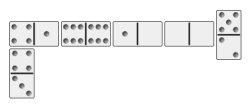Matador Dominoes Rules
How To Play Matador Dominoes
Number Of Players: 2 to 4
Domino Set Required: Normally uses a double-six set, but larger sets may support more players
Matador (or "Matadore") is an interesting variant of The Draw Game, but it uses a different mechanism for connecting dominoes. In Matador, rather than simply matching your tile with an equal end on the layout, you must create a sum of seven. Matador is also sometimes known as Russian Dominoes.
Tiles whose pips add up to 7 (the 1-6, 2-5, 3-4) as well as the 0-0 a called "matadors", and are effectively "wild". They may be played at any time, onto any number, and with either end connected to the open end of the layout. Since a blank (zero) on an end cannot add up to seven with any other value, only a matador may be played on a blank.
Doubles are played lengthwise on the layout. Matadors may be played either lengthwise or crosswise. If played lengthwise, then the expose end becomes the new open end. If played crosswise, then either of the numbers may be used for subsequent summing. If a double-blank matador is played, then the only possible play on it is another matador.
Setup
After shuffling the dominoes, each player draws tiles to make up their hand. The number of tiles drawn depends on the number of players:
- 2 players draw 7 tiles each
- 3 players draw 6 tiles each
- 4 players draw 5 tiles each
The remainder of the tiles make up the boneyard (or "stock"), and are held in or reserve to be drawn upon at need.
Gameplay

The player with the highest double places the first domino. Play proceeds to the left (clockwise). Each player adds a domino to an open end of the layout, if he can.
In the illustration to the right, the double-six was the first tile down. In order to get a sum of seven, the only possible plays are tiles containing a one, or a matador. In this case, a 4-1 was played to the left of the 6-6, and a 1-0 was played to the right. Note that the double is played inline with the other dominoes. At this point, the 4 and the blank are the open ends.
Since one of the open ends is a blank, the only tile that can be played on it is a matador. In this example game, a blank-blank matador was played lengthwise, thought it could have been played crosswise just as well. Again, since one of the open ends is a blank, only a matador can be played on it. Here, a 5-2 matador had been played crossways on the 0-0. On the left end of the layout, a 4-3 matador has been played. Since the 4-3 was played lengthwise, only the 3 is available for further play. But since the 5-2 matador was played crossways, the next tile on the right can sum with either the 2 or the 5, as the player chooses.
Drawing Tiles
If a player is unable to make a move, he must draw a domino from the boneyard. Only one may be drawn per turn. If there are no dominoes left, or if the drawn tile cannot be played, then the player must pass.
Ending A Hand
A hand ends either when a player plays all his tiles, or when a game is blocked. A game is blocked when no player is able to add another tile to the layout.
Scoring
When a hand ends, the player with the lightest hand (i.e. the fewest number of dots on their dominoes) wins the number of sum total of points in all of his opponents hands (minus the points in his own hand, if any).
A game of Matador may be played to any agreed-upon score, typically 100 or 200.
Variations
- Rather than limiting draws to one tile, players must draw until they can make a play, or the boneyard is empty.
- The first double is a spinner, and may be played off on all four edges.
- If a double-nine set is used, connected tiles must add up to 10, and the matadors are 9-1, 8-2, 7-3, 6-4, 5-5, and 0-0.
- If a double-twelve set is used, connected tiles must add up to 13, and the matadors are 12-1, 11-2, 10-3, 9-4, 8-5, 7-6, and 0-0.

 Dominoes Info
Dominoes Info